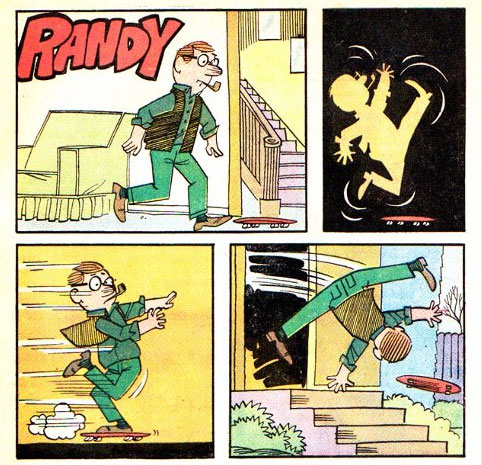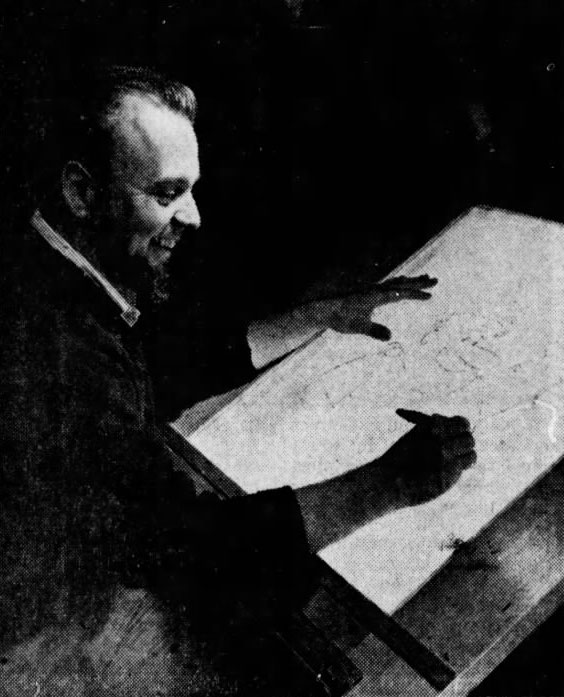Frank Hill was an American cartoonist, illustrator and designer, whose work has appeared in newspapers, books, comics and a host of other media. Throughout his career, he has mainly been a ghost artist and assistant for other cartoonists, having worked with such creators as Frank O'Neal, Hank Ketcham, Charles M. Schulz and Lee Holley. He is best-known for continuing O'Neal's gag comic 'Short Ribs' from 1973 until 1982, writing the 'Bugs Bunny' newspaper comic from 1980 until 1989 and drawing the 'Tom & Jerry' newspaper comic during the 1990s. In addition, he worked as an inker and pencil artist on many comic books with licensed properties, published by Gold Key, Harvey Comics and Archie Comics. Among his personal comics were 'Randy' (1964-1970) and 'Senator Gassius' (1966-1967).
Early life and career
Born in 1929 in Woodland, California, Frank Richard Hill studied at the Academy of Art in San Francisco, and subsequently served in the Navy, where he designed training aids and squadron insignias. After his military service, he worked for the Growers Container Corporation, and then found employment with ad agencies as a layout artist. As art director for Behavioral Laboratories, he developed educational material. With Lee Blair, one of Disney's top animators, Hill worked on character designs and storyboards for a number of TV commercials. In addition, Hill worked for Determined Productions, Worlds of Wonder, Rock-It Science and Smith Novelty Frank on the designs of toys, point-of-purchase displays and other 3-D material.
'Randy'.
Randy
Working from his house studio in Rio Del Mar, Hill had an extensive career in newspaper cartooning and comic book art, but few of his personal creations saw publication. His gag strip about the unlucky 'Randy' (1964-1970) appeared in George A. Pflaum's Catholic comic book 'Treasure Chest', distributed in parochial schools.
Senator Gassius
Between 1966 and 1967, the Lew Little Enterprises distributed Hill's other gag-a-day strip 'Senator Gassius', about the misadventures, policies and politics at a Roman court. In an article in the Santa Cruz Sentinel (31 July 1966), it was mentioned that Hill got the idea for his strip after reading 'Decline and Fall of the Roman Empire'. Seeing the parallels between the Ancient Roman culture and the American, he decided a cartoon about a Roman senator would be a perfect way to poke fun at his country's own society. The senator is a frivolous man, who loves parties, but is also weight-conscious, although he doesn't do anything about it. The other characters ranged from historical figures and an opponent named Gluteus Maximus to the lions in the Roman arena.
'Senator Gassius', 17 June 1967.
Assistant work
As a comic creator, Hill worked mostly as an assistant for other artists, or on comic book stories with licensed characters. In the 1960s, he worked with Frank O'Neal on the newspaper strip 'Short Ribs' (1958-1982) for the Newspaper Enterprise Association. Although the daily gags had a loose continuity, the comic strip lacked regular characters, but instead focused on specific settings, varying from a medieval court, the Wild West or Ancient Egypt. When O'Neal retired in 1973, Hill continued the feature until its final episode in May 1982.
'Dennis the Menace Visits Paris' (1971).
During the 1960s and 1970s, Hill also helped Hank Ketcham on the writing and art of the famous 'Dennis the Menace' strip. Besides the newspaper feature, his contributions included 'Dennis' stories for the early 1970s comic books published by Fawcett, as well as installments of the back-up feature 'Melvin'. At the end of his tenure, he wrote the 'Dennis the Menace' Sunday comic. In 1971, Hill also did some writing for Ketcham's other strip, 'Half Hitch', which was drawn by Dick Hodgins Jr. Together with Jim Sasseville and Dale Hale, Hill was additionally one of the few assistants of 'Peanuts' creator Charles M. Schulz. He never worked on the 'Peanuts' newspaper strip, but made related artwork for children's books and merchandising.
For the comic books published by Dell and Charlton Comics during the 1960s, Hill drew stories with Lee Holley's teenage girl 'Ponytail', and also assisted Holley on the artwork of the newspaper strip in 1968-1969. In the 1980s, Hill worked with Holley again, when he served as scriptwriter for the newspaper comic with Tex Avery's 'Bugs Bunny' for the Newspaper Enterprise Association. Hill wrote the strip from 1980 to 1989, first for Holley as artist, and its final year for Owen Fitzgerald (1988-1989). In the mid-1990s, he also drew the 'Tom & Jerry' newspaper strip for Turner Entertainment, succeeding Kelley Jarvis.
Later comic book work
In the first half of the 1970s, Hill drew for the Gold Key comic books based on Hanna-Barbera's short-lived cartoon series 'The Funky Phantom'. Frank Hill continued to work on licensed properties for Harvey Comics during the first half of the 1990s. These included mainly inking chores on comic book stories with Tim Burton's 'Beetlejuice', Pat Sullivan and Otto Messmer's 'Felix the Cat', the action figures tie-ins 'The Incredible Crash Dummies' and 'Stone Protectors', Friz Freleng's 'The Pink Panther' and Hanna-Barbera's 'Tom & Jerry'.
'New Kids On The Block'. Dutch-language version.
In 1990, Hill was one of the artists of Harvey's celebrity comic series 'New Kids On The Block' (1990-1991), written by Angelo DeCesare, and based on the popular but short-lived boy band of the same name. Pencilers whose work he inked regularly at Harvey Comics were Ernie Colon, Dave Manak and Howard Bender. In 1996-1997, he additionally inked comic book stories with Hanna-Barbera's 'The Flintstones', 'The Jetsons' and 'Yogi Bear' for Archie Comics, and did artwork for coloring books with Paul Terry's 'Mighty Mouse'.
Death
A longtime resident of Soquel, California, Frank Hill passed away on 10 March 2023, at the age of 93. He was father of three children from two marriages.
Frank Hill photographed for the Santa Cruz Sentinel (31 July 1966).









